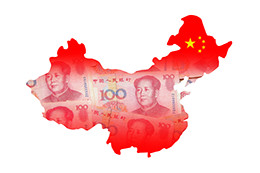 I still want to talk more about oil and the Middle East, and I will, but the more urgent topic is China. What is going on there, and what does it mean for us here in the U.S.?
I still want to talk more about oil and the Middle East, and I will, but the more urgent topic is China. What is going on there, and what does it mean for us here in the U.S.?
The airliner metaphor
A good way to visualize the problem is to think of the Chinese economy as a big airliner, like a 757. It has multiple engines, is optimized to fly at certain speeds, and requires a certain environment (fuel supplies, runways, and so forth) to operate properly. With me so far?
So here's the scenario: China Air has been flying at high speed for some time, but in the past year or so, things have started to go wrong. As the situation worsened, the government tried to land the plane, which is where we are right now.
What went wrong? Well, the plane has three engines: exports, infrastructure in China itself, and, to a much smaller extent, the Chinese consumer. The two big engines, exports and infrastructure, overheated and then started sputtering and slowing down. The fuel for those engines, bank debt, is also starting to run out, with the largely empty tanks now subject to potential explosions (i.e., a banking crisis).
I know, I'm extending the metaphor pretty far, but it more or less fits. And hang on, there's more.
The other engine the Chinese were relying on—the consumer engine—has been a small one historically, but the government has been building it up for the past several years. The stock market was intended to provide fuel for this engine, by letting retail savers invest and grow their net worth. It worked beautifully for a while, but when the market melted down in August, you could say the fuel supply to the new engine caught fire. China thought it had put out the fire, but it’s flaring up again.
Now, the Chinese government is trying to land the plane with two engines struggling and a fuel line fire on the third. I’m not saying it can’t be done, but you can see how the challenges are multiplying. Returning to the point I made the other day, low oil prices have at least provided a runway for China to aim for. Now, though, with the Saudi Arabia/Iran confrontation heating up, it seems that someone may park a tank in the middle of that runway.
Are we in for a rocky landing?
Looking at the bigger picture in China, capital flight means large investors and the wealthy are trying to get off the plane. The continued market crash in the face of trading restrictions on larger investors means that smaller investors are also trying to disembark, by continuing to sell. People are attempting to vote with their wallets, and it doesn’t look good.
The airliner metaphor also provides some context to what analysts mean when we talk about “soft landings” and “hard landings”—an important distinction for the people on the plane. What China must do is land the plane as softly as possible, even as the complications multiply. This is why markets around the world are worried.
What about the U.S. plane? Unlike China, our main engine—the consumer, representing more than two-thirds of the economy—is running smoothly and is well fueled. People are getting jobs and earning and spending more money. Another big engine, the service sector (about seven-eighths of the economy), is also doing well, even though it’s slowing a bit.
Smaller engines—business investment, manufacturing, and exports—are acting sluggish, but the big ones are still solid. We also have a much sturdier runway in place with energy, with U.S. production positioning us to benefit from higher prices.
Some turbulence ahead, but no cause for panic
The Chinese turbulence is certainly rocking the U.S. plane, and we can feel it in the markets and the headlines. That said, fundamentals remain sound, and it’s likely that the U.S. will continue to fly straight and, when necessary, make a smooth landing.
So far, at least, we passengers can sit back and relax, despite the turbulence.


 Print
Print


